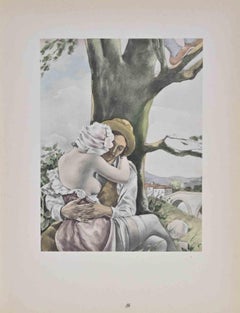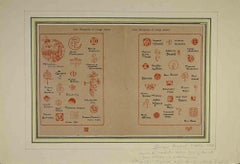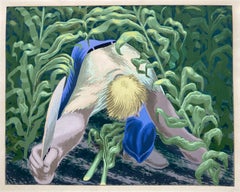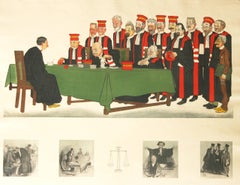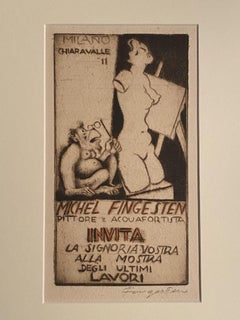1930s Figurative Prints
to
211
957
136
48
25
28
Overall Width
to
Overall Height
to
638
43
41
33
28
22
8
8
2
83
34
27
25
25
3,642
7,764
25,313
6,672
285
583
1,459
1,206
1,250
2,192
3,068
5,178
3,015
1,519
3,110
863
323
6
912
484
475
363
306
243
184
108
88
74
63
62
56
37
33
32
30
26
24
23
465
410
203
90
79
69
467
582
436
Period: 1930s
George Rouault, Christ et Mammon from The Passion, etching, hand coloring
Located in Chatsworth, CA
George Rouault
"Le Christ et Mammon" from The Passion
Original etching with aquatint and hand coloring, initialed lower right
Paper size: 19 x 15.5 inches
Im...
Category
Modern 1930s Figurative Prints
Materials
Etching, Aquatint
Les Amants - Lithograph by Umberto Brunelleschi - 1930s
Located in Roma, IT
Les Amants is a color lithograph on ivory paper, created by the Italian artist Umberto Brunelleschi (Montemurlo 1879- Paris 1949).
Illustration for “Tales and Short Stories” by La F...
Category
Art Nouveau 1930s Figurative Prints
Materials
Lithograph
Some Monograms - Lithograph by George Auriol - 1930s
Located in Roma, IT
Some Monograms is an artwok realized in early-20th century, by the French Artist George Auriol (1863-1935) .
Lithograph on paper. Signed in plate on the left margin. The artist depicts a series of symbols created for artists and collectors.
The artwork is attached on passepartout: 35x50 cm.
Good conditions.
George Auriol (1863-1935) was a French artist, typographer, critic, poet, composer and singer. He began his career as a writer, and in 1885 became the editor of the anti-establishment satirical journal Le Chat Noir, which was closely associated with the Montmartre cabaret of the same name. Auriol composed a number of songs for the Chat Noir, where he met and befriended the artists Henri Rivière, Théophile-Alexandre Steinlen and Antonio de La Gándara...
Category
Modern 1930s Figurative Prints
Materials
Lithograph
PULLING CORN (FODDER HOPPER) - Scarce Print!
By Bernard Joseph Steffen
Located in Santa Monica, CA
BERNARD (JOSEPH) STEFFEN (1907 – 1980)
PULLING CORN (FODDER HOPPER) c. 1935-45
Color serigraph signed with a full signature below the image at the lower right sheet edge . Unknown e...
Category
Modern 1930s Figurative Prints
Materials
Screen
Passing the Bar
Located in Paonia, CO
artist: Adrien Barrere (1877-1931)
title: Passing the Bar
medium: Lithograph
paper size: 19.75 x 25.50
image size: 18 x 24.25
French caricaturist...
Category
1930s Figurative Prints
Materials
Lithograph
Ex Libris - Etching by Michel Fingesten - 1930s
Located in Roma, IT
"Ex Libris" is an Etching, Ex Libris, on ivory-colorated paper by Michel Fingesten .
In excellent conditions: As good as new.
This artwork represents an invitation from the artist...
Category
Symbolist 1930s Figurative Prints
Materials
Etching
Brunelleschi, Composition, La Leçon d'amour dans un parc (after)
Located in Southampton, NY
Lithograph and stencil on vélin d’Arches paper. Unsigned and unnumbered, as issued. Good condition. Notes: From the volume, La Leçon d'amour dans un parc, 1933. Published by Éditions...
Category
Modern 1930s Figurative Prints
Materials
Lithograph, Stencil
$1,436 Sale Price
20% Off
Composition, Le Peseur d'âmes (The Weigher of Souls), Francis Picabia
Located in Southampton, NY
Lithograph and stencil on vélin d'Arches paper. Unsigned and unnumbered, as issued. Good Condition. Notes: From the volume, Le Peseur d'âmes, précédé d'un frontispice et suivi de hui...
Category
Modern 1930s Figurative Prints
Materials
Lithograph, Stencil
$1,436 Sale Price
20% Off
Original Geneva, Festival of Flowers, Geneve, Fete des Fleurs vintage poster
Located in Spokane, WA
Original "Fete des Fleurs" vintage Swiss poster. Archivally linen backed and ready to frame. Printer: "Sonor', Geneva, Switzerland
The Fest...
Category
Art Deco 1930s Figurative Prints
Materials
Lithograph
$1,358 Sale Price
20% Off
'Monday in Wick Haven' original linoleum cut print by Howard Thomas
Located in Milwaukee, WI
In this image, Howard Thomas presents the viewer with a domestic interior. The image is dominated by the figure of a black woman, resting her arm on an ironing board. To the right, the tool of her task dangles a chord above a checker tiled floor. Beyond, though a window, neighboring homes fill the landscape. The careful line-work of the linocut adds a sense of expressionism to the scene, but the image nonetheless falls into the Social Realism that captivated most American artists during the Great Depression.
This print was published in 1936 as part of the Wisconsin Artists' Calendar for the year 1937, which included 52 original, hand-made prints – one for each week of the year.
6 x 5 inches, image
10 x 7.13 inches, sheet
12.37 x 12.43 inches, frame
Entitled "Monday in Wick Haven" lower left (covered by matting)
Inscribed "Linoleum Cut" lower center (covered by matting)
Artist name "Howard Thomas" lower right (covered by matting)
Framed to conservation standards using 100 percent rag matting and museum glass, all housed in a silver gilded moulding.
Quaker-born in Ohio, Thomas trained in the Midwest at Ohio State University and the Chicago Art Institute. He taught in the Art Department of the Milwaukee State Teachers College (now University of Wisconsin-Milwaukee) where he became good friends with Carl Holty, Edward Boerner, Robert von Neumann...
Category
American Modern 1930s Figurative Prints
Materials
Linocut
The Waterfall - Etching by Paul Emile Colin - 1930 ca.
Located in Roma, IT
Etching and drypoint realized by Paul Emile Colin in 1930s.
Edition of 3/50.
Hand signed and numbered.
Very good condition.
Category
Modern 1930s Figurative Prints
Materials
Etching
Bible : Joseph recognized by his brothers - Original Etching (Vollard #220)
By Marc Chagall
Located in Paris, IDF
Marc Chagall (1887-1958)
Bible : Joseph recognized by his brothers (Joseph reconnu par ses frères), 1939
Original etching
Printed signature in the plate
On Montval vellum, 44 x 33.5...
Category
1930s Figurative Prints
Materials
Etching
The Letter - Etching by Paul Emile Colin - 1930s
Located in Roma, IT
Etching and aquatint realized by Paul Emile Colin in 1930s.
Hand signed, numbered and titled.
Edition of 1/4.
Category
Modern 1930s Figurative Prints
Materials
Etching
Original Leipziger Messe International Leipzig Trade Fair vintage poster
Located in Spokane, WA
Original German vintage poster: International Leipzig Trade Fair Leipziger Messe in NYC.
Beginning Feb. 28th, 1937. Held in New York City. Th...
Category
Academic 1930s Figurative Prints
Materials
Lithograph
Swimming under waterfalls - Lithograph by Umberto Brunelleschi - 1930s
Located in Roma, IT
Swimming under waterfalls is a color lithograph on ivory paper, created by the Italian artist Umberto Brunelleschi (Montemurlo 1879- Paris 1949).
Illustration for “Tales and Short S...
Category
Art Nouveau 1930s Figurative Prints
Materials
Lithograph
Henri Matisse, The Hand and the Paintbrush, from Verve, Revue, 1938 (after)
Located in Southampton, NY
This exquisite heliogravure after Henri Matisse (1869–1954), titled La Main et le pinceau (The Hand and the Paintbrush), from Verve, Revue Artistique et Litteraire, Vol. I, No. 4, or...
Category
Fauvist 1930s Figurative Prints
Materials
Lithograph
$716 Sale Price
20% Off
Le Rêve - Lithograph by Umberto Brunelleschi - 1930s
Located in Roma, IT
Le Rêve is a color lithograph on ivory paper, created by the Italian artist Umberto Brunelleschi (Montemurlo 1879- Paris 1949).
Illustration for “Tales and Short Stories” by La Fon...
Category
Art Nouveau 1930s Figurative Prints
Materials
Lithograph
Portugal : The Market - Original Handsigned Etching
By Mily Possoz
Located in Paris, IDF
Mily POSSOZ (1888-1967)
Portugal : The Market, 1930
Original etching
Handsigned in pencil by the artist
Numbered / 60 copies
Blind stamp of the editor Marcel Guiot (Paris)
On vellum...
Category
Realist 1930s Figurative Prints
Materials
Etching
Composition, Le Peseur d'âmes (The Weigher of Souls), Francis Picabia
Located in Southampton, NY
Lithograph and stencil on vélin d'Arches paper. Unsigned and unnumbered, as issued. Good Condition. Notes: From the volume, Le Peseur d'âmes, précédé d'un frontispice et suivi de hui...
Category
Modern 1930s Figurative Prints
Materials
Lithograph, Stencil
$1,436 Sale Price
20% Off
The Speech of Authoritarian - Woodcut print by Paul Baudier - 1930s
Located in Roma, IT
The Speech of Authoritarian is a woodcut print on ivory-colored paper realized by Paul Baudier (1881-1962) in the 1930s.
Good conditions.
Paul Baudier, (born October 18, 1881 in Pa...
Category
Modern 1930s Figurative Prints
Materials
Woodcut
Composition, Le Peseur d'âmes (The Weigher of Souls), Francis Picabia
Located in Southampton, NY
Lithograph and stencil on vélin d'Arches paper. Unsigned and unnumbered, as issued. Good Condition. Notes: From the volume, Le Peseur d'âmes, précédé d'un frontispice et suivi de hui...
Category
Modern 1930s Figurative Prints
Materials
Lithograph, Stencil
$1,436 Sale Price
20% Off
The Courtship - Lithograph by Umberto Brunelleschi - 1930s
Located in Roma, IT
The Courtship is a color lithograph on ivory paper, created by the Italian artist Umberto Brunelleschi (Montemurlo 1879- Paris 1949).
Illustration for “Tales and Short Stories” by L...
Category
Art Nouveau 1930s Figurative Prints
Materials
Lithograph
The Blindfold - Lithograph by Umberto Brunelleschi - 1930s
Located in Roma, IT
The Blindfold is a color lithograph on ivory paper, created by the Italian artist Umberto Brunelleschi(Montemurlo 1879- Paris 1949).
Illustration for “Tales and Short Stories” by La...
Category
Art Nouveau 1930s Figurative Prints
Materials
Lithograph
Clown au Timbale & Clown Assis (2 prints)
Located in New York, NY
Both are color aquatints with same noted dimensions, the sheets with full margins. Both are from an edition of 270. From the portfolio "Cirque." Printed by Maurice Potin, Paris. P...
Category
Fauvist 1930s Figurative Prints
Materials
Aquatint, Color
Ex Libris Mantero - Etching by Michel Fingesten - 1930s
Located in Roma, IT
Ex Libris - Mantero is an Etching print created by Michel Fingesten.
Hand Signed on the right margin. Numbered on the left corner ex. 40/50.
The work is glued on cardboard.
Tota...
Category
Symbolist 1930s Figurative Prints
Materials
Etching
Marie Laurencin, The Sleep of Alice, Alice's Adventures in Wonderland, 1930
Located in Southampton, NY
This exquisite lithograph by Marie Laurencin (1883–1956), titled Le sommeil d'Alice (The Sleep of Alice), from the folio Les aventures d'Alice au pays des merveilles (Alice's Adventu...
Category
Modern 1930s Figurative Prints
Materials
Lithograph
$3,436 Sale Price
20% Off
Circus Girl With Plumed Hat
Located in Santa Monica, CA
YASUO KUNIYOSHI (1893 -1957)
CIRCUS GIRL WITH PLUMED HAT, 1933 (D.L60)
Lithograph, signed in pencil and annotated 25P (edition of 25). Image 12 5/8 x 9 3/8 inches. Full margins w...
Category
American Modern 1930s Figurative Prints
Materials
Lithograph
$3,200 Sale Price
20% Off
Albert Abramovitz, The Wagonette (Moscow Subway)
Located in New York, NY
Albert Abramovitz was working in New York in the 1930s when he made wood engravings of the construction of the Moscow subway. This image, The Wagonette, is a wrenching testament to t...
Category
Ashcan School 1930s Figurative Prints
Materials
Woodcut
The Sweet Awakening - Lithograph by Umberto Brunelleschi - 1930s
Located in Roma, IT
The sweet awakening is a color lithograph on ivory paper, created by the Italian artist Umberto Brunelleschi (Montemurlo 1879- Paris 1949).
Illustration for “Tales and Short Stori...
Category
Art Nouveau 1930s Figurative Prints
Materials
Lithograph
Madame Carmencita, Plate 9
Located in Fairlawn, OH
Madame Carmencita, Plate 9
From: Cirque de l'etoile filante (Circus of the Shooting Star), 1934-1936 (published 1938)
Signed with the artist's initials and dated, lower right of plat...
Category
French School 1930s Figurative Prints
Materials
Aquatint
The Family - Lithograph by Umberto Brunelleschi - 1930s
Located in Roma, IT
The Family is a color lithograph on ivory paper, created by the Italian artist Umberto Brunelleschi (Montemurlo 1879- Paris 1949).
Illustration for “Tales and Short Stories” by La ...
Category
Art Nouveau 1930s Figurative Prints
Materials
Lithograph
Treason - Lithograph by Umberto Brunelleschi - 1930s
Located in Roma, IT
Treason is a color lithograph on ivory paper, created by the Italian artist Umberto Brunelleschi (Montemurlo 1879- Paris 1949).
Illustration for “Tales and Short Stories” by La Font...
Category
Art Nouveau 1930s Figurative Prints
Materials
Lithograph
Constantin Guys, Woman, from Verve, Revue Artistique, 1939 (after)
Located in Southampton, NY
This exquisite lithograph after Constantin Guys (1802–1892), titled Femme (Woman), from Verve, Revue Artistique et Litteraire, Vol. II, No. 5–6, originates from the 1939 issue publis...
Category
French School 1930s Figurative Prints
Materials
Lithograph
$716 Sale Price
20% Off
Bible : The judgment of Solomon, 1939 - Original Etching
By Marc Chagall
Located in Paris, IDF
Marc Chagall (1887-1958)
Bible : The judgment of Solomon (Le jugement de Salomon), 1939
Original etching
Printed signature in the plate
On Montval vellum, 44 x 33.5 cm (c. 17.3 x 13...
Category
1930s Figurative Prints
Materials
Etching
French Woodcut - La Mer et Les Fleuves
Located in Houston, TX
Absorbing black and white woodcut of a nude female figure in the water surrounded by sea life and small figures by French artist Colette Pettier, 1936. Signed, dated and numbered 49 ...
Category
1930s Figurative Prints
Materials
Ink, Paper, Woodcut
The Primitive Family - Woodcut Print by Paul Baudier - 1930s
Located in Roma, IT
The Primitive Family is a woodcut print on ivory-colored paper realized by Paul Baudier (1881-1962) in the 1930s.
Good conditions except for small spots.
Paul Baudier, (born Octobe...
Category
Modern 1930s Figurative Prints
Materials
Woodcut
Stepping Up from La Dame aux Camelias, Art Nouveau Etching after Louis Icart
By Louis Icart
Located in Long Island City, NY
Louis Icart, After, French (1888 - 1950) - Stepping Up from La Dame aux Camelias, Year: 1938, Medium: Hand-Colored Etching, Image Size: 5 x 3.5 inches, Frame Size: 20.5 x 17 inches
Category
Art Nouveau 1930s Figurative Prints
Materials
Etching
Woman with Funny Hat - Stone lithograph, 1930
By Raoul Dufy
Located in Paris, IDF
Raoul DUFY
Woman with Funny Hat, 1930
Original stone lithograph
Unsigned
On Arches vellum 28 x 22 cm (c. 11 x 9 inch)
Excellent condition
Category
Modern 1930s Figurative Prints
Materials
Lithograph
Divine : Young Girl Hidden by the Curtains - Stone lithograph, 1930
Located in Paris, IDF
Andre DUNOYER DE SEGONZAC
Divine : Young Girl Hidden by the Curtains, 1930
Original stone lithograph
Unsigned
On Arches vellum 28 x 22 cm (c. 11 x 9 inch)
Excellent condition
Category
Modern 1930s Figurative Prints
Materials
Lithograph
Whorehouse Scene : Champagne Before Love - Etching
Located in Paris, IDF
Edgar DEGAS (after)
Whorehouse Scene : Champagne Before Love
Etching and aquatint
On Rives vellum 25 x 32 cm (c. 10 x 13 inch)
In the early 1920s, Ambroise Vollard (the great art se...
Category
Modern 1930s Figurative Prints
Materials
Etching, Aquatint
Under Observation - Stone lithograph, 1930
By Yves Alix
Located in Paris, IDF
Yves ALIX
Under Observation, 1930
Original stone lithograph
Unsigned
On Arches vellum 28 x 22 cm (c. 11 x 9 inch)
Excellent condition
Category
Modern 1930s Figurative Prints
Materials
Lithograph
Bible : David ascending the hill of olives, 1939 - Original Etching
By Marc Chagall
Located in Paris, IDF
Marc Chagall (1887-1958)
Bible : David ascending the hill of olives (David montant la colline des oliviers), 1939
Original etching
Printed signature in the plate
On Montval vellum, ...
Category
1930s Figurative Prints
Materials
Etching
Numa suit les Cours de Pythagore - From "Les Métamorphoses d'Ovide"
Located in Roma, IT
Original etching from the portfolio "Les Métamorphoses d'Ovide"publised by Skira in 1931. Illustration "Avec Remarque".
Catalogue Bloch Vol. I n. 128...
Category
Modern 1930s Figurative Prints
Materials
Etching
The Harvest - Etching by Paul Emile Colin - 1930s
Located in Roma, IT
Etching and drypoint realized by Paul Emile Colin in 1930s.
Edition of 5/60. Hand signed and numbered in pencil.
Very good condition.
Category
Modern 1930s Figurative Prints
Materials
Etching
Bible: Noah's coat, 1939 - Original Etching
By Marc Chagall
Located in Paris, IDF
Marc Chagall (1887-1958)
Bible : Noah's coat (Le manteau de Noé), 1939
Original etching
Not signed
On Montval vellum, 44 x 33.5 cm (c. 17.3 x 13.1 inch)
INFORMATION: Published by ...
Category
1930s Figurative Prints
Materials
Etching
Vin Rouge (Red Wine)
Located in Storrs, CT
1932. Drypoint. Appleby 167. 9 1/4 x 11 5/8 (sheet 11 3/8 x 17 15/16). Edition 100 #48. Mat line, well outside the image; otherwise excellent condition. A rich impression with drypo...
Category
Modern 1930s Figurative Prints
Materials
Drypoint
$1,750 Sale Price
30% Off
La Monaca - Lithograph by Umberto Brunelleschi - 1930s
Located in Roma, IT
La Monaca is a color lithograph on ivory paper, created by the Italian artist Umberto Brunelleschi (Montemurlo 1879- Paris 1949).
Illustration for “Tales and Short Stories” by La Fo...
Category
Art Nouveau 1930s Figurative Prints
Materials
Lithograph
Nude - Lithograph by Umberto Brunelleschi - 1930s
Located in Roma, IT
Nude is a color lithograph on ivory paper, created by the Italian artist Umberto Brunelleschi (Montemurlo 1879- Paris 1949).
Illustration for “Tales and Short Stories” by La Fontain...
Category
Art Nouveau 1930s Figurative Prints
Materials
Lithograph
Alexander Calder Circus Reproduction Lithograph After a Drawing
Located in Surfside, FL
(after) Alexander Calder
"Calder's Circus" offset lithograph on wove paper after drawings by the artist
Published by Art in America and Perls gallery in 1964 (from drawings done in t...
Category
American Modern 1930s Figurative Prints
Materials
Lithograph
The Angel - Lithograph by Umberto Brunelleschi - 1930s
Located in Roma, IT
The Angel is a color lithograph on ivory paper, created by the Italian artist Umberto Brunelleschi (Montemurlo 1879- Paris 1949).
Illustration for “Tales and Short Stories” by La F...
Category
Art Nouveau 1930s Figurative Prints
Materials
Lithograph
The Revelation - Lithograph by Umberto Brunelleschi - 1930s
Located in Roma, IT
The revelation is a color lithograph on ivory paper, created by the Italian artist Umberto Brunelleschi(Montemurlo 1879- Paris 1949).
Illustration for “Tales and Short Stories” by L...
Category
Art Nouveau 1930s Figurative Prints
Materials
Lithograph
Ann Nooney, (Demolition with Windows, NYC)
By Ann Nooney
Located in New York, NY
The dimensions are for the image; there are large margins. This lithograph is signed in pencil.
A native New Yorker, Ann Nooney (1900-1970) recorded the urban scene while on the Wo...
Category
American Realist 1930s Figurative Prints
Materials
Lithograph
Constantin Guys, The Dancers, from Verve, Revue Artistique, 1939 (after)
Located in Southampton, NY
This exquisite lithograph after Constantin Guys (1802–1892), titled Les danseurs (The Dancers), from Verve, Revue Artistique et Litteraire, Vol. II, No. 5–6, originates from the 1939...
Category
French School 1930s Figurative Prints
Materials
Lithograph
$716 Sale Price
20% Off
Exposition Esquisses de Rubens 1937 Exposition linen backed vintage poster
By (After) Peter Paul Rubens
Located in Spokane, WA
Exposition Esquisses de Rubens. Musees Royaux des Beaux-Arts de Belgique, Bruxelles. Original, linen backed early (1937) Rubens Exposition. Very rare exposition poster...
Category
Baroque 1930s Figurative Prints
Materials
Lithograph
$1,320 Sale Price
20% Off
Bible : Dance of Mary, sister of Moses, 1939 - Original Etching
By Marc Chagall
Located in Paris, IDF
Marc Chagall (1887-1958)
Bible : Dance of Mary, sister of Moses, (Danse de Marie, sœur de Moïse), 1939
Original etching
Printed signature in the plate
On Montval vellum, 44 x 33.5 c...
Category
Modern 1930s Figurative Prints
Materials
Etching
Composition, Le Peseur d'âmes (The Weigher of Souls), Francis Picabia
Located in Southampton, NY
Lithograph and stencil on vélin d'Arches paper. Unsigned and unnumbered, as issued. Good Condition. Notes: From the volume, Le Peseur d'âmes, précédé d'un frontispice et suivi de hui...
Category
Modern 1930s Figurative Prints
Materials
Lithograph, Stencil
$1,436 Sale Price
20% Off
Bible : Joshua with the angel with the sword, 1939 - Original Etching
By Marc Chagall
Located in Paris, IDF
Marc Chagall (1887-1958)
Bible : Joshua with the Angel with the sword (Josué devant l'ange à l'épée), 1939
Original etching
Printed signature in the plate
On Montval vellum, 44 x 33...
Category
Modern 1930s Figurative Prints
Materials
Etching
Untitled (Pair of Figures) [Couple: Combing Hair on the Beach]
By Jared French
Located in New York, NY
Initialed in pencil, l.r.
Engraving on paper (State II)
12.5 x 9.5 inches (31.8 x 24.1 cm), sheet
8 x 6 inches (20.32 x 15.24 cm), plate
Literature:
Alfonso Panzetta, Jared French...
Category
1930s Figurative Prints
Materials
Engraving
Bible : Moses and Aaron with Pharaoh, 1939 - Original Etching
By Marc Chagall
Located in Paris, IDF
Marc Chagall (1887-1958)
Bible : Moses and Aaron with Pharaoh (Moïse et Aaron devant Pharaon), 1939
Original etching
Not signed
On Montval vellum, 44 x 33.5 cm (c. 17.3 x 13.1 inch)...
Category
1930s Figurative Prints
Materials
Etching
Expressionist Windy Day Portrait
Located in Surfside, FL
Arthur Kolnik was born in Stanislavov, a small town in Galicia, which was then part of the Austro-Hungarian Empire. His father, who was originally from Lithuania, worked as an accoun...
Category
Expressionist 1930s Figurative Prints
Materials
Paper
Still Thinking About These?
All Recently ViewedMore Ways To Browse
Eduardo Roca
Edward B Gay
Edward Hopper Oil Painting
Edward Simmons
Edwin Lord Weeks
Elizabeth Enders
Elizabeth Horning
Emil Holzhauer
England Church Oil Painting
English Deer Painting
English Fox Hunt Painting
English Toy Terrier
Enrique Martinez Celaya
Eric Aho
Eritrea Art
Ernest Chateignon
Erotic Art Animal
Eugene Chigot

